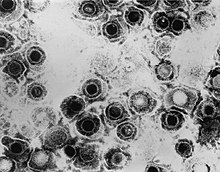Human alphaherpesvirus 2
 From Wikipedia the free encyclopedia
From Wikipedia the free encyclopedia
| Human alphaherpesvirus 2 | |
|---|---|
 | |
| Transmission electron micrograph of herpes simplex virus | |
| Virus classification | |
| (unranked): | Virus |
| Realm: | Duplodnaviria |
| Kingdom: | Heunggongvirae |
| Phylum: | Peploviricota |
| Class: | Herviviricetes |
| Order: | Herpesvirales |
| Family: | Orthoherpesviridae |
| Genus: | Simplexvirus |
| Species: | Human alphaherpesvirus 2 |
| Synonyms | |
| Herpes simplex virus 2 | |
Human alphaherpesvirus 2 or Herpes simplex virus 2 (HHV-2 or HSV-2) is a species of virus in the genus Simplexvirus, subfamily Alphaherpesvirinae, family Herpesviridae, and order Herpesvirales.[1]
Evolution[edit]
Human alphaherpesvirus 2 can be divided into two clades: one is globally distributed and the other is mostly limited to sub Saharan Africa.[2]
Pathology[edit]
Human alphaherpesvirus 2 infects humans, most often as genital herpes. In the United States more than one in six people have the virus.[3] It is primarily a sexually transmitted infection.[4] Human alphaherpesvirus 2 tends to reside in the sacral ganglia. Human alphaherpesvirus 2 is periodically shed in the human genital tract, most often asymptomatically. Most sexual transmissions occur during periods of asymptomatic shedding.[5] Asymptomatic reactivation means that the virus causes atypical, subtle, or hard-to-notice symptoms that are not identified as an active herpes infection, so acquiring the virus is possible even if no active blisters or sores are present.
In one study, daily genital swab samples found Human alphaherpesvirus 2 at a median of 12–28% of days among those who have had an outbreak, and 10% of days among those suffering from asymptomatic infection, with many of these episodes occurring without visible outbreak ("subclinical shedding").[6] In another study, 73 subjects were randomized to receive valaciclovir 1 g daily or placebo for 60 days each in a two-way crossover design. A daily swab of the genital area was self-collected for Human alphaherpesvirus 2 detection by polymerase chain reaction, to compare the effect of valaciclovir versus placebo on asymptomatic viral shedding in immunocompetent, seropositive subjects without a history of symptomatic genital herpes infection. The study found that valaciclovir significantly reduced shedding during subclinical days compared to placebo, showing a 71% reduction; 84% of subjects had no shedding while receiving valaciclovir versus 54% of subjects on placebo. About 88% of patients treated with valaciclovir had no recognized signs or symptoms versus 77% for placebo.[7] For Human alphaherpesvirus 2, subclinical shedding may account for most of the transmission.[6] Studies on discordant partners (one infected, one not) show that the transmission rate is approximately 5 per 10,000 sexual contacts.[8] Atypical symptoms are often attributed to other causes, such as a yeast infection.[4][9]
See also[edit]
References[edit]
- ^ "ICTV Master Species List 2018b.v2". International Committee on Taxonomy of Viruses (ICTV). Archived from the original on March 30, 2019. Retrieved 19 June 2019.
- ^ Burrel S, Boutolleau D, Ryu D, Agut H, Merkel K, Leendertz FH, Calvignac-Spencer S (2017) Ancient recombination events between human herpes simplex viruses. Mol Biol Evol doi:10.1093/molbev/msx113
- ^ "STD Facts - Genital Herpes". www.cdc.gov. December 11, 2017. Retrieved September 22, 2018.
Genital herpes is common in the United States. More than one out of every six people aged 14 to 49 years have genital herpes.
- ^ a b Gupta R, Warren T, Wald A (2007). "Genital herpes". Lancet. 370 (9605): 2127–37. doi:10.1016/S0140-6736(07)61908-4. PMID 18156035.
- ^ Schiffer JT, Mayer BT, Fong Y, Swan DA, Wald A (2014). "Herpes simplex virus-2 transmission probability estimates based on quantity of viral shedding". J R Soc Interface. 11 (95): 20140160. doi:10.1098/rsif.2014.0160. PMC 4006256. PMID 24671939.
- ^ a b Johnston C, Koelle DM, Wald A (Dec 2011). "HSV-2: in pursuit of a vaccine". J Clin Invest. 121 (12): 4600–9. doi:10.1172/JCI57148. PMC 3223069. PMID 22133885.
- ^ Sperling RS, Fife KH, Warren TJ, Dix LP, Brennan CA (March 2008). "The effect of daily valacyclovir suppression on herpes simplex virus type 2 viral shedding in HSV-2 seropositive subjects without a history of genital herpes". Sex Transm Dis. 35 (3): 286–90. doi:10.1097/OLQ.0b013e31815b0132. PMID 18157071.
- ^ Effect of Condoms on Reducing the Transmission of Herpes Simplex Virus Type 2 From Men to Women. A Wald, AGM Langenberg, K Link, et al. JAMA. 2001;285(24):3197
- ^ Koelle DM, Corey L (2008). "Herpes simplex: insights on pathogenesis and possible vaccines". Annual Review of Medicine. 59: 381–95. doi:10.1146/annurev.med.59.061606.095540. PMID 18186706.